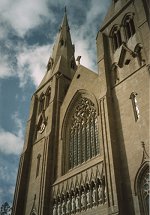
ARMAGH - On May 25, 2003, in the presence of distinguished guests and the general public, His Eminence Cardinal Sťan Brady, Archbishop of Armagh and Primate of All Ireland, formally rededicated his restored Cathedral. Armagh is a remarkable place for many reasons. St. Patrick founded his first church in Ireland here in 445. Set atop seven rolling hills, it has been inhabited since ancient times.
The massive restoration/renovation campaign included the re-design of the sanctuary space of the cathedral, consecration of a new altar, replacement of all major mechanical systems, new roof, stained glass repair, complete cleaning of all interior and exterior surfaces and the installation of a new electric tower clock mechanism.
The project also included the renovation of the 39-bell 1920 Taylor carillon. This instrument has had a chequered history; in its early years it seems to have been quite well used, but by the late 1940's it had fallen into disuse.
Substantial work was carried out by the firm of Armitage Clock & Bells during 1985 and 1986 which made it fully playable again and may well have saved it from total collapse and redundancy. Unfortunately, there was still very little interest in playing the carillon regularly.
INSTALLATION RE-NEWED
In 2003 John Taylor Bell Founders installed new clappers and crown staples throughout and new headstocks for the fourteen smallest bells, new wiring, springs and carriers, new wire steadiers, adjusters and weatherboard. On top of that a new keyboard (North-American standard) was supplied. Due to the extreme weather conditions and years of neglect, the old keyboard needed replacement.
The existing frame and rollerbars (not original) were retained in accordance with the procedures regulating restoration of historic buildings in Ireland. Furthermore every part of the mechanism was cleaned and lubricated and the frame re-painted. New louvres were also put in place. The fine-tuning of the installation was supervised by Gideon Bodden from The Netherlands.
As part of a week long celebration Steven Ball from the USA played several recitals on the cathedral carillon. The carillon itself is quite remarkable in that it is now the oldest intact example of a carillon by Taylor anywhere in the world.
The sound of the bells is rich, dark, vibrant and singing. They speak with a powerful voice which, due to their unique installation in the North tower of the building and the beautiful situation of the cathedral campus high atop its hill, resound throughout the city. The overall effect of the instrument and the work is just stunning - well worth the trip for any visitor. Following this major work it is hoped that the Armagh carillon will be played much more in the future.
